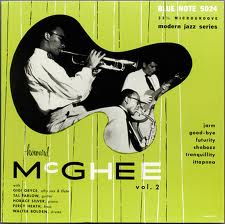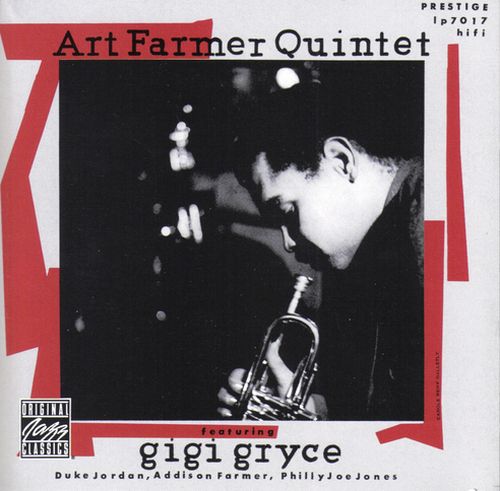Shabozz – Gigi Gryce
An exotic medium swing but with a Latin introduction and coda and a shout chorus notated in all melody and second parts. Our Gigi Gryce Project version has Minus You tracks for all instruments. A Concert Condensed Score is also available for the first recorded arrangement, from a 1953 Howard McGhee session.
- Recording: Howard McGhee - Howard McGhee Volume 2
- Recorded on: May 10, 1953
- Label: Blue Note (BLP 5024)
- Concert Key: E-flat minor
- Vocal Range: , to
- Style: Swing (medium up)
- Trumpet - Howard McGhee
- Alto Sax, Flute - Gigi Gryce
- Guitar - Tal Farlow
- Piano - Horace Silver
- Bass - Percy Heath
- Drums - Walter Bolden
Video
- Description
- Historical Notes
- Solos
- Piano Corner
- Bass Corner
- Drum Corner
- Guitar Corner
- Inside & Beyond
- Minus You
There is an eight-measure interlude starting after six measures of the C section, with a different not-quite-Latin groove; the trumpet has the melody for this section, which modulates to B minor for a solo break. The solos are in the key of B minor. After the last soloist, a four-measure drum break sets up the shout chorus back in E♭ minor; the three-part triadic voicings here use trumpet on top, with guitar in the middle and alto on the bottom. The bridge of this last chorus is a piano solo, followed by the C section out; the intro reappears as a coda right after the sixth measure of the C section instead of following a drum break. Like the intro, this coda begins with four measures of rhythm section only before the horns and guitar come in. On the last measure of the coda, there is a descending piano fill that also appears in the Art Farmer version; because it is obviously a notated figure, we include it here.
For lead sheets, click on either of the other two album covers. The last one, for "The Gigi Gryce Project" includes Minus You audio tracks.
This was Tal's only session with our composer Gigi Gryce.
Between this recording and the Art Farmer one from 1955, Shabozz was also recorded on a session of all Gryce compositions on November 2, 1953 in Paris, by a quintet led by pianist Henri Renaud. Gryce does not play on this recording, which features tenor saxophonist Bobby Jaspar. This version is much faster than the other recordings, with slightly different melodic rhythms and no shout chorus. The piano and bass are tacet for the intro and ending.
Don Sickler: Sometimes on record dates you don't get an individual part. In our case, you are lucky to get to see all of the notes that everybody plays. The melody of this arrangement of Shabozz is all played by guitar (Tal Farlow), so it's not difficult to read your melody part, which is always on top.
When the guitar part is inside a stacked voicing, that is a different situation. I have a suggestion for when you have an inside voice part, as the guitar has for the intro, coda, and at H, the alternate melody which starts the out chorus. If your goal is to play your part with the original recording, and if you don't want to take the time to write out the guitar part for those sections, just write the names of the notes above or below the staff for each note in those sections.
Related Songs
Email Send Shabozz to a friend
- Recording: Art Farmer - Art Farmer Quintet Featuring Gigi Gryce
- Recorded on: October 21, 1955
- Label: Prestige (PRLP 7017)
- Concert Key: E-flat minor
- Vocal Range: , to
- Style: Swing (medium)
- Trumpet - Art Farmer
- Alto Sax - Gigi Gryce
- Piano - Duke Jordan
- Bass - Addison Farmer
- Drums - Philly Joe Jones
Video
- Description
- Historical Notes
- Solos
- Piano Corner
- Bass Corner
- Drum Corner
- Guitar Corner
- Inside & Beyond
- Minus You
Authors Noal Cohen and Michael Fitzgerald, in "Rat Race Blues: The Musical Life of Gigi Gryce," "Shabozz is one of Gryce's most captivating and difficult compositions. . . . Despite the harmonic complexity with which Gryce endowed the piece, it does not sound contrived or pretentious. Shabozz is a unique and haunting theme and an overlooked gem in the hard bop repertoire."
Note that all lead sheets plus a rhythm section part and Minus You audio tracks are available under The Gigi Gryce Project album cover.
Gryce wrote his first arrangement of Shabozz for a Howard McGhee sextet date for Blue Note Records; click on the first album cover for more information. After the recording featured here, on December 17, 1957, Gigi arranged and recorded an octet version of Shabozz that he wrote for Dizzy Gillespie's "The Greatest Trumpet Of Them All" session for Verve Records. That session included pianist Ray Bryant and drummer Charli Persip.
Learn more about Gigi Gryce at Noal Cohen's Jazz History website. Also see Gryce's discography.
Related Songs
Email Send Shabozz to a friend
- Recording: Gigi Gryce - The Gigi Gryce Project
- Recorded on: September 2, 1999
- Label: jazzleadsheets.com (JLS 1024)
- Concert Key: E-flat minor, No key center
- Vocal Range: , to
- Style: Swing (medium up)
- Alto Sax - Bobby Porcelli
- Tenor Sax - Ralph Moore
- Piano - Richard Wyands
- Bass - Peter Washington
- Drums - Kenny Washington
Video
- Description
- Historical Notes
- Solos
- Piano Corner
- Bass Corner
- Drum Corner
- Guitar Corner
- Inside & Beyond
- Minus You
It should be mentioned that this song is written without a key signature. Because of the many key centers in the chord progression, and especially the cyclical A section progression (which begins in E♭ minor but ends in F♯ minor), we feel that a key signature would make the chart more difficult to read.
-- intro
-- melody
-- piano solo 2 choruses
-- tenor sax solo 2 choruses
-- alto sax solo 2 choruses
-- shout chorus (1) 2 A sections
-- bass solo on the B and C sections
-- out melody
-- coda
There are two different Minus Melody tracks, a practice edition with the same format and a shorter performance edition. In the practice edition, the soloist has the opportunity to play accompanied by bass and drums only. The performance edition has 2 choruses with full rhythm section.
mp3 minus melody this track works for any melody instrument, minus you for the entire original track
-- count off sets up the intro
-- play the intro and melody
-- solos—practice edition: 2 choruses with bass and drums only 4 choruses with full rhythm section
performance edition: 2 choruses with full rhythm section
-- play the shout chorus 2 A sections
-- play the out melody B and C sections and coda
mp3 minus Piano get the rhythm section part
-- count off sets up the intro
-- comp/fill for the intro
-- comp for the melody
-- solo 2 choruses
-- comp for the tenor and alto solos 2 choruses each
-- comp for the shout chorus 2 A sections
-- comp for the bass solo B and C sections
-- comp for the out melody and coda
mp3 minus Bass get the rhythm section part
-- count off sets up the intro
-- play figure for the intro
-- walk for the melody
-- walk for the piano, tenor, and alto solos 2 choruses each
-- walk for the shout chorus 2 A sections
-- solo for the B and C sections
-- walk for the out melody
-- play figure for the coda
mp3 minus Drums—sticks throughout - get the rhythm section part
-- count off sets up the intro
-- comp for the intro and melody
-- comp for the piano, tenor, and alto solos 2 choruses each
-- comp for the shout chorus 2 A sections
-- comp for the bass solo B and C sections
-- comp for the out melody and coda
mp3 bass & drums only
This bass & drums only track also works great as a feature for guitar or any other instrument (tenor saxophonist Sonny Rollins loved to play with just bass and drums, for example)
-- count off sets up the intro
-- play the intro and melody
-- solos—2 choruses with full rhythm section
-- play the shout chorus 2 A sections
-- play the out melody B and C sections and coda
Related Songs
Email Send Shabozz to a friend

Gigi Gryce
November 28, 1925 – March 17, 1983
Gigi Gryce was a fine altoist in the 1950s, but it was his writing skills, both composing and arranging (including composing the standard Minority) that were considered most notable. After growing up in Hartford, CT, and studying at the Boston Conservatory and in Paris, Gryce worked in New York with Max Roach, Tadd Dameron, and Clifford Brown. He toured Europe in 1953 with Lionel Hampton and led several sessions in France on that trip. Read more...



